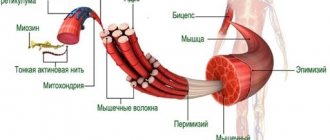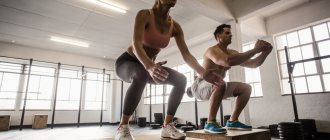Basic exercises for developing strength
Training may vary. There are three types of suitable exercises:
- With the presence of external resistance. It can be divided into 3 more types - using weights, exercising with a partner, or overcoming environmental obstacles.
- Overcoming your weight. There are also 2 types that can be used - strength exercises from gymnastics and jumping from athletics.
- Isometric. Creation of passive and active muscle tension.
Exercises with external resistance
This type of exercise is the most effective in terms of developing strength, and therefore it is the main thing that should be included in your training regimen. In the process of their implementation, overcoming muscle work is carried out, their isotonic contraction is achieved. Due to the heavy load and regular training, strength gradually increases.
Lesson options:
- Using weights. Typically, dumbbells, kettlebells, and barbells are used for this. They can also be replaced with some types of simulators that do not limit the time for performing each approach. Depending on the chosen techniques and equipment, you can influence both a specific muscle and its part.
- With a partner. Exercises are used in which resistance is applied to the muscles using the weight or strength of another person. They are convenient because they do not require a mandatory visit to the gym: if you have a partner, you can work out at home.
- In the external environment. Its resistance refers to uncomfortable conditions for classes. For example, running against the wind, in the snow, exercises on ice, on sand, etc. can be used.
IMPORTANT! The effort performed must exceed the usual level. Therefore, if at some point the exercises begin to seem too easy, you need to increase the load or replace them with others.
Types of strength abilities in physical education
There are 2 types of muscle efforts - absolute and relative. The first group is considered to be able to demonstrate maximum strength characteristics in a relatively short period of time. Absolute muscle tension is expressed in kilograms. Relative strength is taken into account during motor activity associated with body movement.
In physical education it is:
- run;
- jumping;
- riffles;
- crawling;
- climbing and other activities.
Determination of relative strength capabilities is used for dosing and distribution of physical activity. The degree of permissible muscle tension is calculated in the ratio of 1 kg of lifting mass per 1 kg of body weight.
Strength in physical education is a concept that is divided into several types of muscle load:
| Type of effort | Description and examples |
| Isometric | Fastening muscle fibers in a fixed position - on the crossbar and other sports equipment. |
| Power | Pull-ups, cycling |
| Dynamic | They are determined by the movement of the limbs - running, jumping, swimming, throwing sports equipment. |
| Overcoming | Overcoming obstacles, exercises with a hoop and others. |
The development of each type of physical qualities has its own characteristics and patterns. What unites them is only the involvement of motor function by physiological means of the musculoskeletal system and the central nervous system.
Strength abilities
A complex of manifestations in various types of physical activity and activities.
Such characteristics are influenced by numerous internal and external factors, with their contribution changing depending on:
- the current state of the body;
- exercises performed;
- operating conditions;
- age;
- gender identity;
- individual anatomical features.
Internal influencing factors of strength capabilities include muscle characteristics, neurological parameters, and psychological criteria. This also includes the biomechanical characteristics of the body. There are specific strength characteristics, which include speed, agility, and endurance. Their relevance depends on the type of physical exercise.
Speed-strength abilities
They are distinguished by moderate muscular tension, far from the limit of the body's capabilities. They are determined by the situationally required effort and can reach maximum values for a short time.
Such characteristics are important during push-off movements in jumping, final acceleration when throwing an athletic projectile, and spurt when running long or short distances.
The less external resistance an athlete overcomes, the more significant the role of the strength component. With relatively insignificant weighting, the value of the speed component increases.
These abilities include explosive and fast power. The latter is not distinguished by the extremes of muscle effort. Explosive tension is used to achieve maximum muscular activation during a certain period of action or exercise.
Fast Power
The ability to achieve the greatest physical tension per unit of time. In relation to sports disciplines, fast force involves imparting maximum acceleration to one’s own body, an athletic equipment or their individual parts.
This physical characteristic can be represented in the form of realized impulse energy, determined by the duration, the interval at which the peak load is reached, and the slope of the force increase graph. The level of rapid force depends on the muscular stretch-shortening cycle. It differs from speed-strength load in the isometric and concentric values of muscle fiber shortening.
Explosive force
A physical characteristic that reflects the ability to achieve maximum neuromuscular tension in the shortest period of time - usually in the first 0.2-0.3 s. after the start of a sports movement.
Explosive force in combination with the technique of performing the exercise determines the speed capabilities of muscular power. Athletic movements using this ability are called plyometric or ballistic movements.
Strength in physical education is a definition that includes a complex of anatomical, physiological and biochemical factors.
This is especially evident when using explosive voltage, which is provided by:
- impulse frequency in the initial phase of contractile movement of muscle fibers;
- motor neuron signal synchronization, called neural coordination;
- indicators of muscular ability to rapidly contract;
- level of hypertrophy of fast-twitch muscle structures.
The development of explosive strength is necessary in sports disciplines that require sudden movements of increased power. These include shot throwing, sprinting, martial arts, and some team sports.
Strength endurance
The ability to implement relatively high impulse muscle tension for a given period of time during loading movement. Strength endurance is characterized by a non-significant difference between the maximum possible effort and what is actually achieved in a certain time interval.
This is the body's ability to resist fatigue when the body functions at power close to maximum. The duration of endurance is determined in the range of 3-4 minutes. and is realized through anaerobic-glycolytic energy conservation.
Strength endurance is important when working with heavy weights of sports equipment or athletic equipment. It is characterized by minor muscle contractions. If the mass is relatively small, such endurance is called general.
Dynamic
The ability of muscle structures to perform heavy sports work of moderate intensity over a significant time distance. Dynamic endurance is directly related to the strength characteristics of the body.
For its development, weighting agents of 50% of the maximum value for a particular organism are intended. Such exercises are performed at a moderate rhythm. You need to work until you get very tired. Between sets, take even time breaks for recovery.
Static
It is considered typical for sports activities associated with prolonged retention of maximum or moderate muscle tension necessary to maintain a certain body position in space.
Static endurance is developed with the help of isometric exercises, the duration of which is limited by the phase of compensatory fatigue. The loads are 82-86% of the maximum possible.
A variety of techniques allow you to effectively work on any muscle group. The starting position and joint bending angles should be such that the target muscle structures are involved in the work.
Power Agility
Accurate differentiation of muscle tensions of various magnitudes in non-standard situations and combined modes of sports activity. The concept is directly related to the speed of the reaction.
Strength agility is especially evident at the physiological level with a variable rhythm of functioning of different muscle groups. It is in demand in volleyball, football, and hockey.
Additional Strength Development Factors
In addition to exercise, there are a number of factors that affect your level of physical strength. If any of them noticeably “sags,” the classes may not give the desired result. Let's look at the factors that anyone working on strength development should pay attention to:
- Correct execution of the selected exercises. If the technique is violated, the result may be several times less than expected, and injuries or pain in the joints cannot be ruled out.
- An interval of 1-2 days between training for one muscle group. It is a well-known fact: muscles need time to rest. Therefore, either classes are required every other day, or different workouts are structured so that there is a break between them.
- Periodic change of exercises. Working on the same muscles leads to lower results with the same load. Changes are needed from time to time.
- Balanced diet. A separate topic that an amateur athlete should study at least superficially, and one who wants to become a professional should study in detail.
- Healthy sleep. The average minimum, with the exception of individual cases, is a stable 7-8 hours a day. Training is a lot of physical activity, and if a person doesn’t get enough sleep, he simply won’t have enough strength. Although this may not appear immediately.
- Regularity of training. What you started should not be abandoned, just as you should not take long breaks.
By adhering to the rules described above, you can achieve good results in developing strength. Specialized information will help you do everything more correctly and avoid mistakes.
What's the secret?
Have you ever noticed that a thin person can be many times stronger than a well-fed, healthy person? The answer is simple - thin people may simply have better developed tendons. And you don’t need to be surprised, it’s the tendons, not the muscles. Experts note that tendons are the main mechanism of our strength. Their task is to connect muscle tissue to bones, which will serve as the basis for the very strength that will allow you to achieve the most incredible results. There are also drugs that increase physical strength, but their use is not approved by doctors.
Basic methods for developing physical strength
- Myometric method , which involves muscle work in an overcoming mode. This is the main method in powerlifting and bodybuilding. The athlete spends the main effort when performing exercises while lifting weights, especially with large and maximum loads.
- Plyometric method , which involves working muscles in a yielding mode, in which it is possible to develop a much greater absolute value (10–30%) muscle tension than in overcoming tension.
- Isometric (static) method . This is a reliable means for developing muscle strength through static exercises. During training, static efforts of general muscle tension are used (up to 100% of the maximum for 5–10 seconds) and local efforts of individual muscle groups (up to 50% of the maximum for 15–30 seconds).
- Combined mode method , combining the properties of overcoming, yielding and isometric methods. It is actively used by high-class athletes in many strength sports. This method is effective when the athlete works 75% of the training time in the overcoming mode, 15% in the inferior mode and 10% in the holding mode.
Article: Means and methods for developing strength abilities.
Article
Means and methods for developing strength abilities.
When working on the development of strength abilities in the educational and training process, the teacher sets several main tasks:
- General harmonious development of all muscle groups of the human musculoskeletal system. This problem is solved by using selective strength exercises. At the same time, their volume and content are important. They must ensure proportional development of various muscle groups.
- Versatile development of strength abilities in unity with the development of vital motor actions, skills and abilities. This task involves the development of strength abilities of all main types.
- Creating conditions and opportunities for further improvement of strength abilities within the framework of practicing a specific sport or in terms of professional applied physical training.8
As a means of developing strength, physical exercises with increased weights or resistance are used, which specifically stimulate an increase in the degree of muscle tension. Such means are called force. These include:
1. Exercises with the weight of external objects: barbells with a set of disks of different weights, collapsible dumbbells, kettlebells, balls, ground weight.
2. Exercises weighted with your own body weight:
- exercises in which muscle tension is created due to the weight of one’s own body (hanging pull-ups, push-ups, maintaining balance while standing, hanging);
- exercises in which your own weight is burdened by the weight of external objects (for example, special belts, cuffs);
- exercises in which your own weight is reduced through the use of additional support;
- impact exercises in which one’s own weight increases due to the inertia of a freely falling body (for example, jumping from a height of 25-70 cm and then immediately jumping up).
3. Exercises using general type training devices (for example, a weight bench, a power station).
4. Jerk-braking exercises,
which are performed with a rapid change of tension during the work of synergistic muscles (triceps, leg and buttock muscles, latissimus dorsi, biceps) and antagonist muscles during local and regional exercises with and without additional weights. As a rule, these muscles perform the same contractile function in various exercises. Synergists move parts of the body in one direction. Antagonist muscles are antagonistic to each other based on anatomical characteristics. For example, the muscles located in the chest area are pressers, the muscles located in the back are responsible for traction.
5. Static exercises in isometric mode (isometric exercises), in which muscle tension is created through volitional efforts with or without the use of external objects in self-resistance. Such exercises can be various supports, holds, supports, and counteractions.9
In the practice of physical education, a significant number of methods are used aimed at developing various types of strength abilities.
One of the main methods for strength training of athletes is the maximum effort method, which involves performing tasks related to overcoming maximum resistance (lifting a barbell of maximum weight). It is based on the use of maximum, submaximal and supermaximal weights. Thanks to this method, the athlete’s ability to concentrate neuromuscular efforts develops, and strength increases due to the improvement of intramuscular and intermuscular coordination. This method is not recommended for classes with children, and for qualified athletes, it is used no more than 2-3 times a week. Large weights are used at intervals of 7-14 days. Exercises with weights over 100% of the maximum are performed in a yielding mode (muscle strength is manifested when it lengthens) using the help of a partner or special devices. The number of approaches to performing the exercise varies depending on the weight of the weight, but does not exceed five. Recommended rest intervals are 2-5 minutes between sets and 4-6 minutes between reps per set. The pace of movements is arbitrary, speed - from low to maximum.10
The method of repeated non-maximum efforts involves the use of non-maximum weights from 30 to 80% of the individual maximum, with a maximum number of repetitions until failure without rest in each approach. Various options can be used:
- exercises are performed in one approach to failure;
- the exercise is performed to failure in several approaches;
- performed to failure in each approach and the number of approaches also to failure.
Depending on the magnitude of the weight, which does not reach the maximum value, and the direction in the development of strength abilities, a strictly standardized number of repetitions is used, which can be more than 20 times.
In physiological terms, the essence of this method of developing strength abilities is that the degree of muscle tension approaches the maximum as you get tired. By the end of the activity, the intensity, frequency, and sum of nerve-effector impulses increase, a larger number of motor units are included in the work, and the synchronization of voltages increases. A high volume of muscular work with unsaturated weights activates metabolic and trophic processes, causes muscle hypertrophy with an increase in their physiological diameter, and stimulates the development of maximum strength.
The advantage of the non-limiting weights method is the ability to control movement technique, reduce straining when performing strength exercises, and reduce the risk of injury. This method is suitable even for beginner athletes, since their development of strength almost does not depend on the amount of resistance. This method is considered appropriate when it is necessary to develop the magnitude of force, when speed manifestations are not important.11
The method of static (isometric) efforts involves performing short-term maximum tensions, without changing the length of the muscles. In the case when the task is to develop maximum muscle strength, isometric tension is used at 90% of the maximum for 4-6 seconds. If the goal is to develop general strength, use isometric tension at 60-80% of the maximum for 10-12 seconds in each repetition. Typically, during a workout, 3-4 exercises are performed, 5-6 repetitions of each, with a 2-minute rest between exercises. Rest periods are usually filled with relaxation and stretching exercises, as well as breathing exercises, to promote rapid recovery of the body. It is also advisable to use dynamic exercises between approaches.
Isometric exercises can be included in your workouts up to 4 times a week, devoting 10-15 minutes to them. The set of exercises should be used unchanged for 4-6 weeks and then updated. In this case, the starting positions in similar exercises should change, as well as the directions of influence on different muscle groups should be updated.
When performing isometric exercises, it is important to choose the correct position and joint angle. With a large joint angle, the effect of force development is reduced. Isometric stress at joint angles of 90 degrees affects the increase in dynamic strength of the torso extensors. The posture when performing exercises should correspond to the moment of manifestation of maximum effort in a sports exercise.
The isokinetic force method does not set the amount of external resistance, but a constant speed of movement. Exercises are performed with special simulators that allow you to perform movements in a wide range of speeds and exert maximum or close efforts in any phase of movement. This allows the muscles to work with optimal load throughout the entire movement.
This method is used primarily to develop slow, fast and explosive strength. It provides increased strength capabilities in a relatively short period of time compared to the repetitive and isometric effort method. Since this method actively uses simulators, the risk of muscle and joint injuries is reduced, since technical devices are adapted to the individual capabilities of the athlete. In this case, you can achieve greater strength with fewer repetitions.12
The dynamic effort method consists of creating maximum power tension by working with unlimited weights at maximum speed. This method is used to develop fast and explosive strength. As a rule, the exercise is performed in several approaches with a number of repetitions up to 25 times. The recommended rest time between sets is 5-8 minutes. The weight of the weight is relatively small (up to 30% of the maximum), and the amplitude of execution is maximum.13
The shock method is based on shock stimulation of muscle groups by using the kinetic energy of a falling load or the weight of one’s own body. The absorption of this energy contributes to a sharp transition of the muscles to an active state and the rapid development of working force. This creates additional tension potential in the muscle, which ensures the power and speed of subsequent movement, and therefore a quick transition from inferior to overcoming work. This method allows you to mobilize the reactive properties of muscles, is aimed at developing the explosive strength of various muscle groups, as well as improving the reactive ability of the muscular system. Using the impact method requires preliminary preparation. When performing exercises with weights using the impact method, certain conditions must be observed:
- apply these techniques only after preparatory exercises;
- the number of repetitions of the exercise should not be more than 5-8 times;
— the magnitude of the impact is determined by the weight of the load and the magnitude of the working amplitude;
— the initial pose is selected taking into account the position at which the working force develops in the exercise being trained.14
The statodynamic method involves a combination of isometric and dynamic muscle work in an exercise. In this case, they usually use isometric exercises for 2-6 seconds with an effort of 80-90% of the maximum, and then dynamic explosive exercises with a significant reduction in weight. It is recommended to do 2-3 sets with 2-3 repetitions each and rest between sets for 2-4 minutes.
The method of circular training, which provides a complex effect on various muscle groups, is characterized by conducting exercises at “stations”. It is important that the exercises in each subsequent series involve a new muscle group. The number of exercises affecting different muscle groups and the duration of their implementation may vary depending on the characteristics of the participants, their age, level of preparedness, as well as the tasks facing them. The circuit training method involves performing exercises that act as continuous or interval work. In powerlifting, circuit training aimed at developing strength usually consists of 8-10 exercises, the sequence of which is determined in such a way that each subsequent exercise loads different muscles that were stressed in the previous exercise. At the same time, work at each station is 20-30 seconds, and rest between stations is also 20 seconds.15
Two groups of exercises are used as means of developing strength and power abilities:
- With external weights (weight of a weight, barbell, load; resistance of elastic objects; resistance of a partner; resistance of the external environment).
- With weights of your own body.
Exercises with objects are easier to dose, affecting different muscle groups. However, with large weights, static tension predominates in the initial period, therefore, the speed-power nature of the movement is disrupted. From an organizational point of view, they require special equipment for the training area.
With self-weighting, you can give a large load in a short period, and no special equipment is required. However, when using these exercises, there is a loss of muscle elasticity and a decrease in neuromuscular coordination of movements. In this case, the load can be adjusted by changing the reference (initial) position.
When using elastic objects (shock absorbers, expanders), the force increases towards the end of the movement. For uniform tension, it is recommended to use long rubber. If it is necessary to concentrate efforts in the initial period, you should use short rubber and a rigidly elastic expander or object.
An essential point in developing strength is the choice of resistance value. The pace of strength exercises should be average. This provides greater strength gains. At the maximum pace, work efficiency decreases due to deterioration in the coordination of nervous processes due to an increase in the flow of affective impulses and the subsequent irradiation of excitation of the central nervous system.
Optimal number of repetitions
Standard strength exercises require 20-25 repetitions, but the number of approaches is determined by the basic exercises. You can stop for a break for 2-4 minutes; this time is enough to replenish energy reserves and continue training. A standard strength training routine can be based on 5 sets of 5 reps. You can give a simple example: if your repetition maximum is 125 kilograms, then the weight of the bar should be 100 kilograms, and the number of repetitions should be 5. After which you need to rest for a couple of minutes and start a new set of the same exercises. Typically, when working on strength, the number of approaches does not exceed 5.
What is the essence of the program?
Exercise allows the body to develop, thereby training the following qualities:
- Maximum strength is the ability to lift the most weight.
- The goal of strength endurance is to work on muscle definition, as well as develop the ability to exert maximum effort for a certain time.
- Explosive strength training allows you to improve your performance in certain sports. For example, in sprinting, jumping and so on.
Developing these three indicators will help increase physical strength and endurance.
The influence of strength level on muscle growth in bodybuilding
In bodybuilding, increasing strength is a desirable, but far from the main factor in muscle growth.
More precisely, for beginners and people with an average level of physical fitness, there is a linear relationship between the increase in working weight in all exercises and the growth of muscle mass.
That is, the more weight you use in training, the more muscle you have.
Naturally, all exercises must be performed perfectly. Violation of exercise technique in combination with heavy weight is a 100% guarantee of injury. Moreover, you get injured much faster than you have time to build muscle.
However, for advanced levels, especially for professional bodybuilders, the rule of heavy weights no longer always works. Therefore, experienced gym goers with solid muscle mass use other methods to stimulate muscle growth.
As for beginners, their strength increases naturally. All this is thanks to normal but regular physical activity and a gradual increase in working weight, to which the body has to adapt. This is one of the main reasons for the rapid gain of muscle mass in people with little experience.
True, such rapid progress is observed in the first 3-4 months of training. Next, the body completely gets used to exercising with weights and partial adaptation occurs.
The growth of strength and muscle mass slows down or stops altogether. To progress further, you need to continue to increase your training weights. This means it's time for special training.
Despite the simplicity of the idea, 5x5 training in its pure form is very difficult. And either people genetically gifted for strength training or bodybuilders taking anabolic steroids can benefit from them.
Here the principle of load periodization begins to be actively used, for example:
First, there are 4-6 weeks of strength training, where mainly multi-joint exercises are performed. Isolation is practically not used during this period.
This is followed by 6-8 weeks of mass training, using traditional bodybuilding techniques. The lesson consists of 60-70% basic exercises and 30-40% isolating exercises. Then the cycles repeat.
By applying this fairly simple periodization scheme, you can progress in results over many years. Moreover, progress is observed both in strength indicators and in muscle volume.
An increase in the level of strength in basic exercises during the strength period provokes an increase in all working weights. And this, as you remember, creates the preconditions for a new increase in muscle volume during the period of weight training.
If there is a need to reduce the level of subcutaneous fat, a third final cycle is added to the periodization scheme - relief training.
A little history
Not so long ago, in the 20th century, there lived an interesting man, Alexander Zass. His fate was not easy, he participated in the First World War, was captured and even managed to escape several times. But then the war ended, and Alexander went on a trip to Europe with the thought of what he should do. Here he began doing exercises aimed at developing tendons, after which he achieved enormous strength and began performing in the circus with the most incredible programs. He tore thick chains with his bare hands, lifted horses, and could even prevent the blow of a sledgehammer. Such strength raised many questions among the audience, and, based on his own experience, Alexander presented to the world his system of exercises, which allowed others to also achieve such results.
Your body is your trainer
Exercises using your own body weight are generally easy to perform. In addition, they do not require additional equipment, except that it is better to take care of comfortable clothes and shoes for training in advance. You can perform strength and other types of exercises with your own weight both at home and outdoors. True, if the goal of training is not to maintain your current shape, but to build muscle mass, gradually your own body weight will become an insufficient load and you will have to practice exercises with your own weight.
or move to the gym.
How does exercise using your own body differ from other types of exercise? they do not require additional tools to perform them
in the form of exercise machines, weights, dumbbells or other weights. All necessary load is provided by the body. For example, a similar load can be obtained by lifting weights, such as a barbell, or doing pull-ups, i.e. lift your own body. You can use simulators to train your leg muscles by doing lifts with weights, or you can do squats.
Exercises with your own body weight are easy even for beginners, because this type of exercise is the most natural for our body, such a load will not be excessive for the body, in addition, it can be easily adjusted by reducing or increasing the number and duration of approaches. Since exercises to overcome your own weight do not require special training, you can perform them yourself, without resorting to the services of trainers. However, special attention must be paid to the technique of performing the exercises so that the result meets expectations.
How to distribute the load?
It is absolutely obvious even for a beginner that in order to increase your own strength, you need to properly regulate the load. The question of how to do this most effectively and without harm remains open. First you need to determine your repetition maximum for each exercise you perform. This indicator will correspond to the minimum weight that you can lift or push in one go. This is necessary in order to work on progress during further training and increase the result each time. Typically the load depends on the goals being pursued. For example, if you want to gain muscle size, trainers recommend performing a minimum of 75% of your rep maximum, and if your goal is to increase physical strength, then this figure can be increased to 85-100%.
Alexander Zass system
The most popular and effective exercise turned out to be wall pushing. The whole point is that tendons develop only when force is applied to a stationary object. This is where pushing the wall, tug-of-war, which is fixed in the floor, and so on come to the rescue. Alexander did not stop at these exercises. He found that it was much more effective and convenient to perform exercises with conventional chains. The point is simple: Zass made a couple of hooks for easy adjustment of the length of the chains and began working out all his muscle groups in static mode.
The point is that in an attempt to break the chain in different positions in the body, a stable force wave is created, which persists for a couple of seconds, and then you need to slowly come out of this tension, relaxing. And the task in this case is not to try to break the chain, but to create a force wave so that the chain will soon break on its own.
The second point that is worth paying close attention to is breathing. If you breathe intermittently and sharply, then nothing will work. Breathing should be smooth and calm. Inhale slowly with increasing tension, then hold the force wave and exhale smoothly with relaxation.
And if Zass had to come up with his own training devices, now you can find many options. Metal fittings, rope, and wooden sticks will help in this matter. Exercises can be very ordinary. You can try bending a thick metal rod, squeezing a stick, or lifting a heavy object. Only the field of such exercises strains the whole body, including muscles and tendons. The body enters the force wave that Alexander spoke about. Only by regularly repeating the same exercise, an athlete develops the part that is responsible for the strength of the tendons - the strength that allows you to do incredible things.











